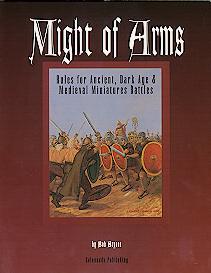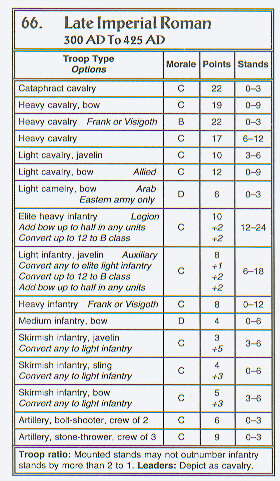

| |
These are rules for large miniatures battles from ancients (1600
BC) through the late medieval (1500AD) period. The game focuses on the role
of various troop types rather than a highly detailed interaction of weapons
and armor types.
In addition to the basic rules, the games includes a number of optional rules of added complexity for those so inclined. Also, one hundred and fifty army lists are included. Each list notes the point cost per stand for various troop types, as well as restrictions on the quantities which may be used.  |
|---|---|
| Period | up to 1500 AD |
| Scale | Figure Scale: For use with either 25mm, 15mm, or 6mm figures. |
| Ground Scale: Depends on figure scale. For 25mm, 1"= 20yds. For 15mm, 1"= 30yds. For 6mm, 1"= 60yds. | |
| Time Scale: 30 minutes per turn. | |
| Figure Ratio: Depends on troop type. One figure = 100 men for pike or skirmish infantry, 50 other infantry or cavalry, 2-6 elephants, 10-20 heavy chariots, or 20-40 light chariots. | |
| Basing | Figures are based on stands with a frontage of about 50yds according to the scale of the figures. Two figures per stand are used for light infantry and cavalry, 3 for most other cavalry and medium infantry, and 4 for heavy/knight infantry as well as cataphract cavalry. Artillery,chariots, and elephants are based individually. Units are organized by stands rather than figures. |
| Contents |
|
| Designer | Bob Bryant |
| Publisher | First edition published 1996 by Colonnade Publishing |
| hatton ([email protected]) |
|---|
| Most of my ancients gaming has been done using 7th. I have always found the
overall result to feel realistic. However, they are probably the worst
written rules I have every seen and prone to contradiction/ambiguity. So
with my head spinning, I went in search of a well-written, comprehensive,
straight-forward set of rules which would still give that same satisfaction
at the end result.
Might of Arms was recommended. The price is excellent, and the rules were with me within a week (I am U.K.-based, so that is excelllent). For the price, I expected a few pages. However I got 108 pages! The rules are easy to read with loads of examples and diagrams. There is a playsheet for fast reference. The mechanics are quite easy to get to grips with. And (most importantly) I don't have to rebase my troops to play these! All in all...a successful buy. |
| Kurtus A. Brown ([email protected]) |
| I have played many sets of rules, including Piquet/Archon, Armati,
Classical Hack, and DBA/DBM. I am really impressed with Might of Arms (MOA).
In many ways they blend some of the better aspects of the above rules in
to one. And by using the author's optional rules for small battles
("Mini-MOA", as he calls it) I can fight battles with about the same number
of models as for DBA and 'intro-scale' Armati.
The rules are clean, easy to play/learn, easy to add your own rules, and they are complete. IMO, this is what makes them better than any of the other rules sets. From what I understand, the author is working on some rules to expand the rules to cover up to 1700 AD. This is a great thing, as I also play this later period. I highly recommend these rules for anyone interested (veteran and novice alike) in Ancients, Dark Age, Middle Ages, or Renaissance gaming. They are a breath of fresh air from the DBx games, and have lots more detail than say DBA/Armati. And not only that, you can get a copy from the author at a greatly reduced price!!! |
| Dan Dionne ([email protected]) |
| The game has clean, conventional wargame mechanics - no radical new approaches
in terms of the game turn or the command structure. It has most of the
elements that old-time wargamers find missing in more modern games - figures
organized in multi-stand units, morale rules. At the same time, it avoids
the complications of most of the old rules sets by classifying troops and
then building a combat matrix around those classifications.
The rules seem to be designed for Classical and Medieval Europe - most of the special rules reflect those. I know Bob is heavily focused on Romans, and he also has a number of knight-specific rules and classifications. I'm very impressed with the rules layout and the playing aids as well. The only set I know as clearly laid out is Armati (which is really a game that works at a different scale). |
| Lew Beckerdite ([email protected]) |
| Let me begin by saying the I like these rules. I have played a number of Medieval systems over the years. I found the Might of Arms (MOA) system to be the best. I believe that MOA combines good historical flavor with the all-important ease-of-play factor. |
| Ken Dale ([email protected]) |
| I was one of the playtesters for MOA and contributed to its development, so
I am very familiar with the game. The following are my own opinions - the
designer may not agree.
MOA started as a "better WRG 6th" - Bob and I played many games of 6th Edition in the 80's, gradually changing the mechanics and deleting many of the modifiers to speed play. We tried 7th Edition and Tactica but were disappointed in them, so Bob developed a new set. MOA reminds me of 6th Edition in its scale and in the way that units are deployed (a unit is usually 2-4 stands of cav or 4-8 stands of inf, with the stand sizes the same as WRG). MOA is designed so that forward movement is easy, but tricky maneuvers are difficult (for example, changing formation in MOA takes an entire turn). Shooting is done by rolling one die per stand, melee with one die per unit, and morale with two dice per unit. Figures and stands are not removed; instead units accumulate hits and fatigue points which hurt their morale. The battle is won by reducing the enemy's morale until he breaks. I recommend MOA to players interested in a tactical-level ancients game where morale and maneuver are emphasized, rather than weapons and armor. |
| Rich Villella ([email protected]) |
| My club is using Might of Arms and we're enjoying it. You
can play a large game with 20 units of 3-6 stands each in just a couple of
hours. (Less, if your morale rolls are as bad as mine were last
week.)
Combat procedure is pretty standard - move into contact, calculate combat factors and roll the dice - but you inflict fatigue rather than casualties. Too much fatigue results in morale failure and a speedy exit from the battlefield. Like me, last week...Grrr... Standard tactics, such as flanking pike blocks and massing more men on the enemy than he does on you, apply. |
| [email protected] |
| First, I would like to say that these are very well written rules. They are well organized, read easily, and there are numerous diagrams and examples included. Second, the rules are meant to provide a reasonably fast game for large battles. I think they succeed pretty well here. Movement is generous, but not excessively so. Heavy infantry move 4" (in 15mm scale) and heavy cavalry move 8" with an additional 3" and 5", respectively, when charging. Combat is simple, but not simplistic. You cross index attacking and defending troop types to get a base number. Then consult a list of about 10 modifiers and add a d6 random factor. Cross-index the total with the number of stands in your unit to determine hits. Figures are not removed from the table. Instead, when the number of hits on a unit equals the number of stands, the hits are exchanged for a fatigue point marker. These affect when and how well the unit tests morale. Morale and fatigue are the dominant factors in combat. Also, players are encouraged rather than forced into historical tactics. For example, rather than forcing you to maintain a "battleline" (or whatever other rules choose to call it), you are encouraged to do so by morale penalties for unsupported flanks if formed infantry. Finally, while these rules may be too simple or lacking in detail for some, I think the the majority will find them very enjoyable. For those who want more detail, there are optional rules provided or you can add your own. If you're fed up with WRG "Xth" edition or DB "Rock, Paper, Scissors, give these a try. They're not perfect, but they are a major step in the right direction. |
If you would like to add your opinion to this webpage, use the following form or send email to the editor.
If you know of any resources for this game, or if you have material you would like to make available to the Net, please let us know.
| Last Updates | |
|---|---|
| 28 August 1999 | comments by hatton |
| 6 July 1999 | comments by Kurtus A Brown |
| 28 May 1999 | comments by Dan Dionne |
| 14 May 1999 | comments by Lew Beckerdite |
| 16 April 1999 | comments by Ken Dale comments by Rich Villella |
| Comments or corrections? | |